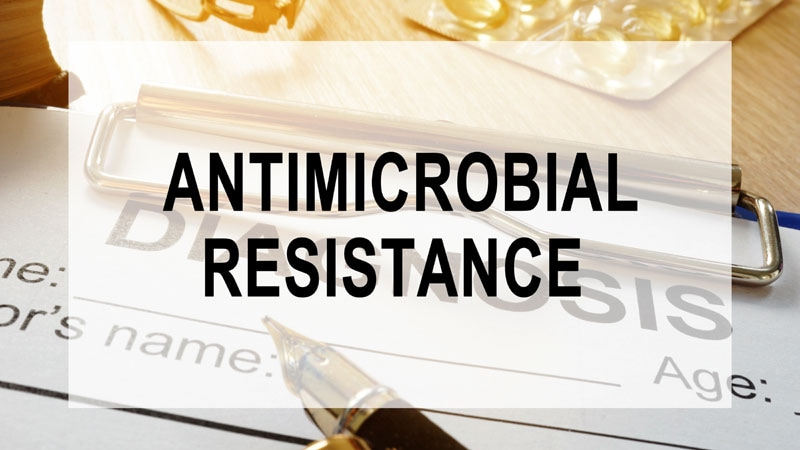The COVID-19 pandemic erased years of progress in combating antibacterial resistance in the United States, according to a special report from the US Centers for Disease Control and Prevention (CDC).

Arjun Srinivasan, MD
“It is frightening to see the extent of the impact,” Arjun Srinivasan, MD, CDC’s deputy director for program improvement in the Division of Healthcare Quality Promotion in Atlanta, and a contributor to the report, told Medscape Medical News.
“In 2019, CDC reported that nationwide investments in prevention drove down deaths from antimicrobial-resistant infections by 18% from 2012 through 2017. CDC data show these reductions continued until 2020,” Srinivasan, a captain in the Commissioned Corps of the US Public Health Service, explained in an email. “But the pandemic resulted in more resistant infections, increased antibiotic use, and less data and prevention actions.”
In the new report, CDC analyzed antimicrobial resistance in the US from 2012 to 2020. The 2020 hospital cohort comprised nearly 600 US hospitals that represented around 17% of hospital discharges, Srinivasan added. Organisms with available data showed these bacterial increases:
-
Carbapenem-resistant Acinetobacter (78%)
-
Carbapenem-resistant Enterobacterales (35%)
-
Extended-spectrum beta-lactamase (ESBL)–producing Enterobacterales (32%)
-
Multidrug-resistant Pseudomonas aeruginosa (32%)
-
Vancomycin-resistant Enterococcus (14%)
-
Methicillin-resistant Staphylococcus aureus (13%)
Antifungal infections also increased:
-
Antifungal-resistant Candida auris (60%)
-
Antifungal-resistant Candida (excluding C auris) (26%)
Although Clostridioides difficile data were not available for the report, the authors suggest that, based on related CDC data, C difficile infections decreased, probably in part because of changes in health-seeking behavior.
The Pandemic Created the Perfect Storm
“The pandemic pushed public health near breaking point in 2020,” Srinivasan noted in an email. “CDC saw a significant increase in antimicrobial use and difficulty in following infection prevention and control guidance, resulting in an increase of antimicrobial-resistant healthcare-associated infections in US hospitals.”
From March to October 2020, roughly 80% of patients hospitalized with COVID-19 received an antibiotic. During the first year of the pandemic (2020), hospital-onset infections and deaths increased at least 15%.
“The threat of antimicrobial-resistant infections has gotten worse, especially in hospitals. During the first year of the pandemic, over 29,400 people died from healthcare-related antimicrobial-resistant infections,” Srinivasan said in an email. “And almost 40% of those people became infected in the hospital.”
The total number of deaths from antimicrobial resistance may actually be much higher, he added, but pandemic-related gaps in data cloud that analysis.

Lindsay Ann Petty, MD
Lindsay Ann Petty, MD, a clinical assistant professor specializing in infectious diseases at University of Michigan Health in Ann Arbor, was not surprised by the report.
“Hospitals were overwhelmed with sick, complex patients requiring prolonged ICU stays, in the face of little data on treatment and rates of bacterial co-infection,” Petty, who was not involved in developing the report, told Medscape Medical News.
“This led to the perfect storm for antimicrobial resistance: decreased infection prevention optimization, including decreased personal protective equipment and shared rooms; decreased antimicrobial stewardship efforts due to priorities shifted to COVID; and increased antimicrobial use (both unnecessary in the face of the unknown, and necessary due to complications of prolonged ICU stays),” she said in an email.
“Antimicrobial resistance is one of the greatest public health threats of our generation,” Petty said. “Antibiotic use affects not only your patient, but also your patient’s neighbor.”
“Rates of bacterial co-infection are low in COVID-19, so antibiotics should be used sparingly and not used for typical symptoms of COVID,” she added.
Regaining Lost Ground
For Srinivasan and his colleagues, the most important question to answer right now is, “How do we ensure these setbacks are temporary?”
“The nation must invest in prevention to be better prepared for future threats, regain lost ground on this public health threat, and save lives,” he urges.
Clinicians and healthcare facilities can take these steps to protect patients from hard-to-treat and untreatable infections and to combat antimicrobial resistance, he advises:
-
Follow infection prevention and control practices with every patient, every time.
-
Improve how you prescribe antibiotics and antifungals. Antibiotics are not effective against COVID-19 because antibiotics do not treat infections caused by viruses.
-
Encourage your patients to prevent infections and to stay current on vaccinations.
Srinivasan invites providers to access resources at CDC’s Project Firstline collaborative, which provides infection control training to US healthcare and public health workers, and to engage with the US National Action Plan for Combating Antibiotic-Resistant Bacteria collaboration to combat antimicrobial resistance.
“We each have a role to play in combating antimicrobial resistance,” he said. “We need to take continued aggressive action to prevent infections in the first place, improve antibiotic and antifungal use to slow the development of resistance, and stop the spread of resistance when it develops.”
“CDC is working with a variety of partners to learn more about how we can ensure that infection prevention and antibiotic stewardship activities that were paused during the pandemic come back on-line,” Srinivasan added.
The report contributors do not report any relevant financial relationships. Petty reports no relevant financial relationships.
COVID-19: US Impact on Antimicrobial Resistance, Special Report 2022 is a publication of the Antimicrobial Resistance Coordination and Strategy Unit within the Division of Healthcare Quality Promotion, National Center for Emerging and Zoonotic Infectious Diseases, Centers for Disease Control and Prevention. The report is also available here.
For more news, follow Medscape on Facebook, Twitter, Instagram, and YouTube
Source: Read Full Article
